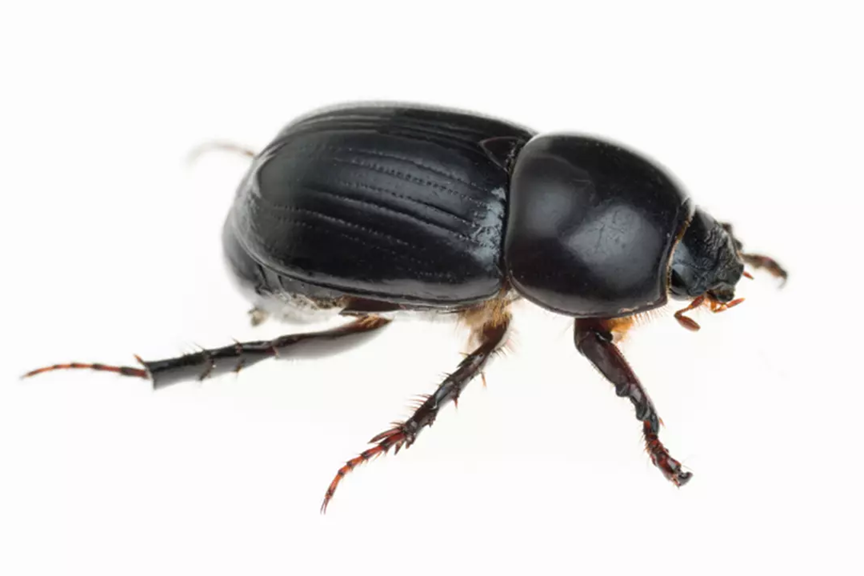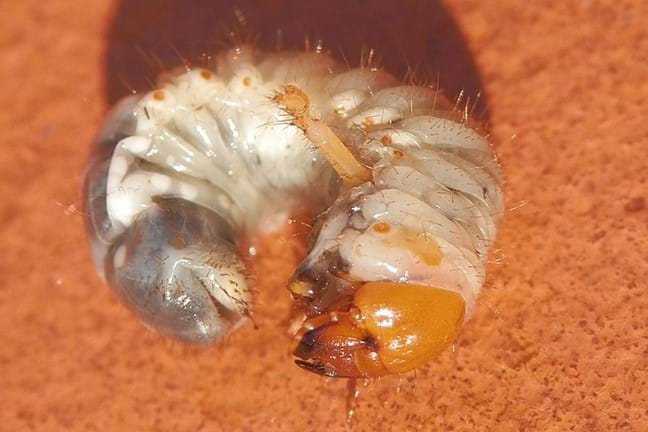African Black Beetle Control in Your Lawn & Garden
Coleoptera : Heteronychus arator

Coleoptera : Heteronychus arator

For the control of African Black Beetle (adult stage) in lawns and turfed areas try Yates Advanced Lawn Insect Killer. Also controls Mole Crickets, Couch Mite, Ants, Armyworm, Cutworm, Webworm and the adult beetle stage of Billbug, Argentine Stem Weevil and Scarab.
See Curl Grub for the Best Treatment for Curl Grubs - the larval stage of the African Black Beetle.
When digging in the garden collect any larvae or adults and either feed to the birds or place pests into a bucket of soapy water. Drain off the excess water, place dead pests in a plastic bag and place into the rubbish bin.
If you have chickens or other fowl allow them to roam freely in and amongst the garden, lawn and turfed areas to feed on adults and first larval instar.
For large vegetable garden beds, allow beds to rest for a period, turning over the soil every now then exposing larvae and adults to predators such as birds.
For particularly infested beds, to prevent adults from laying eggs into the soil, plant crops in mid-summer to winter; and to prevent adults from feeding, plant crops in winter. Alternatively, plant an overabundance of crops at any time of year.
Plant a wide variety of crops as pests often preferentially feed on some crops and not others - this will reduce the effects of monoculture.
To prevent plant death of ringbarked woody plants, slightly mound the soil over damaged stem or trunk.
Prune the foliage of trees and shrubs which have had their roots chewed and thereby root system reduced. Prune up to a third of the total foliage as this will help to rebalance the root-to-shoot-ratio.
Keep plants, lawns and turfed areas well-watered and fertilised until adequately recovered from attack. For Lawns apply Yates Dynamic Lifter Organic Lawn Food and for most garden plants (including native plants) apply Yates Dynamic Lifter Soil Improver & Plant Fertiliser. Yates Dynamic Lifter products are organic based plant fertilisers that improve soil quality and structure, and enhances pest and disease resiliency.
The African Black Beetle (Heteronychus arator), also known as the Black Lawn Beetle or Black Maize Beetle, is an introduced pest species from Africa and is found in most parts of Australia (excluding Tasmania).
Adults
The adult beetles are glossy black, oval-shaped and generally 12 - 15mm long. On the underside of most of the body are light-brown bristle-like structures (setae). At the front of the body is the head, which is short, broad and angles downwards. At the front of the head are chewing mouthparts. On either side of the head are a pair of compound eyes and short, golf-club-like antennae. Behind the head, on the upper side of the body, is a large trapezoid-shaped plate (pronotum) which is the front segment of the middle section of the body (thorax).
Attached to the underside of the thorax are 3 pairs of legs which are lightly covered in spines. The upper portion of the leg is slightly flattened while the lower leg is thinner and thread-like. However, in males, the lower portion of the front legs are also slightly flattened. At the tips of the legs are claws. The hindlegs are the largest pair which are used for digging.
Adults have 2 pairs of wings, the outermost wings are hardened forewings (elytra) and used to protect the delicate membranous hind-flight-wings. While at rest, forewings fold down over the flattened hindwings and meet in the centre of the body, forming a distinct straight line. At the top of this line is a small triangular-shaped plate known as the scutellum. Along the length of the forewings are straight, mostly parallel indented lines.
Larvae
The grub-like larvae have a creamy-white body with an orange-to-brown rounded head capsule and black jaws. The hind section of the body is generally swollen, baggy and grey-blue to green in colour due to the visible contents of the gut. The body is long, tubular, C-shaped and heavily segmented, growing up to 25mm long. At the front, along either side of the body, at each segment are a pair of orange-brown spots which are used for breathing (spiracles). On either side of the head are a pair of compound eyes and at the front of the head are chewing mouthparts. Antennae are small and generally inconspicuous. Attached to the underside and middle section of the body are 3 pairs of thin 5-segmented legs. Larvae are wingless.

Normally, there is just one generation of African Black Beetle per year, however, depending on the environment it may take up to 2 years to complete the entire lifecycle.
Eggs
In spring, after mating the female adult lays eggs just underneath the surface of vegetation. Eggs are small (1.8 mm), round and cream-coloured. Females lay between 6 and 12 eggs individually, laying approximately 30 eggs in her lifetime.
Larvae
After 2–5 weeks, eggs hatch and grub-like larvae emerge. Larvae develop through 3 larval stages (instars) where they grow then shed their exoskeleton (a process known as moulting) at each stage. After hatching, the first instar is 5mm long. At the second instar larvae burrow into the soil. After developing into the third and final instar stage, fully mature larvae are typically 25 mm in length and ready to pupate. Larvae are generally active throughout most of spring and summer.
Pupae
In late summer to early autumn, mature larvae dig a chamber in the soil to create an 'earthen cell'. Larvae 'clear their guts' of food and become a pale-yellow colour. As pupae develop, they become slightly darker and redder in colour and shorter (15 mm long) and more rounded in appearance. During the pupal stage, pupae do not feed, are mostly inactive and gradually transform into the adult form.
Adults
After pupating for approximately 2 weeks, adults emerge in late summer and autumn. Over winter, adults become less active and in cold conditions hibernate in the soil until emerging in spring where they are mature and ready for mating. Adults generally survive for 10 months, dying soon after reproducing in spring.
At the first instar stage, larvae feed on decaying organic matter just above the soil surface. At the second and third instar stage larvae exclusively feed below ground on plant and grass roots and other below-ground parts of plants. Adults mostly feed on plant and grass shoots just above or below the soil surface (up to 15 cm deep).
Adults are slow walkers and crawl mostly during the breeding season. Flying mostly occurs at night – particularly in autumn, less often in spring - where they are especially drawn to and fly towards artificial lights.
Birds, Foxes, Rats and Mice, Nematodes, and some Microorganisms.
Further evidence of African Black Beetle includes physical signs of eggs, larvae, pupae and adults - see description and lifecycle for identification.
Both potted plants and plants in the ground, especially young plants, seedlings, small growing and thin-wooded plants are particularly vulnerable to pest attack. Edible plants including vegetables, herbs, tomatoes, citrus and fruiting trees may be impacted. Examples include: